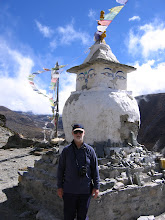Uganda, Kasese to Kampala – July 26th
Early in the morning I had to shoot out of bed with another bout of diarrhoea – probably a result of all the fruit juice the previous day. I decided to knock it over with Flagyl and Lomotil (aka Loctite) as we would be travelling to Uganda by bus. After breakfast we went down to the bus stop and met Mr Singi - a very pleasant Mzee who was a fount of information about the attractions of Western Uganda. We found a bus leaving for Kampala ‘soon’ so headed back to the Hotel to check out and take that bus. We got on the bus at 9:20am and didn’t leave Kasese until 10am. Before leaving the town the bus did a cruise around the streets touting for passengers – what a service!
The journey back to Kampala was pretty much the same as the journey out only in reverse. Again we saw Impala, Buffalo, Baboons, and Uganda Kob in Queen Elizabeth Park. We came across an amusing sign just outside the town of Mbarara. It was a normal black-and-white painted Zebra crossing with a sign proudly proclaiming ‘Donated by the Lions Club of Mbarara’. We could just imagine a pride of lazy, hungry lions waiting in the long grass by the side of the road for the Zebras to cross. Maybe we were still light-headed from lack of food!
Along the way there were several stops at which refreshments could be bought either through the bus window or from some of them who came aboard while the bus was stopped. These were colourful sights with lots of activity going on.
During the bus ride to Kampala I took the time to look at the architecture of houses seen along the way. One incongruous design was a mud-walled hut with a corrugated iron roof and the ridge of the corrugated roof capped with clay tiles.
Summing up the domestic architectures encountered, there appeared to be a progression from the simplest/cheapest to the more technologically intensive and thus more expensive designs. The simplest was undoubtedly the traditional round, mud-walled, thatch-roofed hut. Next in sophistication, if that's the appropriate word, was a hut built to a rectangular pattern with the walls constructed of mud formed on an armature of saplings. The roof was again of thatch.
Next again up the ladder of sophistication was a rectangular hut made of mud bricks. This may have a thatched roof, or one of corrugated iron. The corrugated iron roof probably denoted a slightly more sophisticated sub-classification of this style.
A variation on the previously described style was the use of baked mud bricks but with otherwise the same construction. And then last of all were huts constructed of fired clay bricks and possibly concrete floor and corrugated iron roofing.
The method of baking or firing mud bricks was similar to the making of charcoal:
* Build a stack of mud-bricks – hollow in the centre
* Build a fire in the middle
* Seal the outside and leave it to cook and cool.
There was some very nice-looking basketry for sale along the roadside but no opportunity to stop and check it out. We eventually arrived in Kampala around 5pm into the midst of traffic chaos. When we were eventually able to get off the bus we got into a taxi to the Sheraton Hotel but they had no rooms available so it was on to the Fairway where we were able to get a room for US$89. Then we had to check out flight availability from Entebbe to Nairobi as we didn’t want to spend another 15 hours on a bum-numbing bus ride. We managed to get a booking for 8am the following day but had to go straight to the Uganda Airline office to pay the US$110 each for the tickets.
The TV in the hotel room seemed to have only one channel which varied between CNN and CTV. There were some amusing cartoons on CTV including "Duck Tales, Zoo Olympics". Dominic phoned the Fairview in Nairobi to reserve a room for our return but they couldn’t confirm it. We were to call again from Nairobi Airport on arrival. This was probably a standard practice due to the uncertainties of travel in Africa.
Subscribe to:
Post Comments (Atom)







No comments:
Post a Comment